|
The FZ1 has the
R1 race bred 1 liter engine developing nearly 120 rear wheel HP stock.
A Modern Muscle Bike right out
of the box? Yes. |
[] IowaZ Sitemap [] Send Email [] FZ1 Owner's Association [] IowaZ Vmax Sitemap [] IowaZ V65 Magna Page []
Use the FZ1 Sitemap to navigate all of the FZ pages.
Yamaha FZ1
OIL CHANGE & INFORMATION
What Oil should one Use in the FZ1?
....The Great Oil Debate, is one of the "exciting" topics
of Cycle Land! Everyone has opinions and their opinions are
right. Sure! Study the issues and go with your best
"guess" but keep an open mind to change. If not sure, you will
not go wrong with cycle companies recommendations.
….Yamaha recommends Yamalube 4 (20W40) or SAE 20W40 type SE motor oil.
….In a motorcycle the engine oil also lubricate the clutch (more importantly
it acts to cool the clutch). The wrong oil types or additives could therefore
cause clutch slippage.
….Yamaha does not recommend using any oil additives.
....I changed the first time at 500 miles, however one can go longer on the
break-in oil, from 600-1200 miles. Like all oil issues there are
numerous opinions on when to change the first time and how often plus the oil
type to use.
...I will use Yamalube for the first change or about 2000 miles, then
transfer over to Mobil 1, full synthetic
cycle oil. I have used Mobil 1, 15W50 auto in the Magna for years, and
Torco 20W50 full synthetic in the Vmax since 1996. Mobil 1 cycle, in
2000, became much easier to find in the auto supply stores and Wally Worlds,
so easily availability will be the reason to use Mobil 1 cycle in the
FZ1. I am likely to switch over to Mobil 1 for the Max when my supply of
Torco runs out, as Torco has to be ordered and the price has climbed well over
the cost of Mobil 1.
....In motorcycles the clutch is "bathed" in the same oil that
lubricated the engine, primarily to act as a cooling agent for the clutch
plates. Since synthetic oil has vastly superior lubricating qualities, the
theory is the clutch plates will not have enough friction between them to stay
engaged and will slip on reach other. Major slippage can be/will be felt
as a hesitation or like a deceleration/braking sensation. Minor slippage
may feel like a slight "chugging" action. Unfelt slippage at a
microscopic level is my concern. What is actually happening at the micro
level? The plates my be microscopically moving on one another under
insufficient clutch spring force and therefore wearing excessively. Many
of the Vmax crowd simply install "better" clutch plates/kits and
heavier springs, whether using synthetic or dyno oil. There are some
major, major wrenches in the Max group and they seem close to evenly divided
on dyno or syn oil. The SabMag (Sabre/Magna) riders know their bikes
have almost no oil pressure in the upper heads as a result of Honda's major
mistakes and great cover up of the issue. Thus almost to a man/lady,
they run full synthetic because of the superior lubrication qualities.
Even when a oil mod is done to get oil to the upper heads, nearly all of the
group runs syn if they know and understand the issue with the upper heads on
the early Honda V4's.
....Since I come out of the Honda cover up times, I am a champion of synthetic
oils and will continue to use them in my Muscle Bike fleet until clutch
slippage or damage occurs. None yet, after years of use :))
.....How often do I change oil. Every year in the Max and Magna.
With three cycles these two bikes do not receive many miles per year and are
being kept relatively classic. The FZ will be the main runner and
probably get an oil change every 2-4k miles. I tend to run a lot more
miles on full synthetic oils. In fact I really do not worry about
mileage anymore. I do watch the oil level carefully and I do watch for
water or "dirt" in the system, but other than that, I let Mobil 1 or
Torco handle things without worry.
....I also change plugs every year and try to bleed the brakes/clutch and
change coolant every other year, if not every year. If you want an easy
way to bleed lines and therefore make changing line fluid
"pleasure," surf into the Vmax sitemap and find the clutchline page.
Drop to the bottom of this page for a
log of my oil change intervals and comments.
Filter and Oil Selection
....I tend to use nothing but factory filters.
....Oil of choice, which will be
Yamalube the first couple of changes, then Mobil 1 synthetic cycle.
Changing the FZ Engine Oil
….Start engine, warm it up for several minutes, or better yet let the
engine cool enough after a ride to easily work on the oil change. There are
some riders who make a good argument for changing oil in a cold engine. I
generally try to change after coming in from a ride.
….Gather equipment and clean-up supplies. Have everything ready to go so
time is not taken to hunt items down. ....You
will need an oil wrench, funnel, oil drain pan, 17mm six point socket, ratchet
with extension bar, also I would suggest having a good breaker bar available
for any "first" maintenance on the FZ as the factory used blue
locktite on most of the fasteners.
….Place an oil collection pan under the engine oil drain plug, which is
under the frame tube on the lower left side of the engine crankcase.
….Remove the engine oil filler cap, which is the black plastic
"knob" on top of the clutch housing on the right side of the engine.
This will equalize air pressure and allow the oil to freely flow from the
drain opening.
….Remove the engine oil drain bolt along with its gasket. Be sure to wipe
off the oil drain bolt and check the metal gasket. The bolt and gasket
are good items to pick up and keep in your "extra" parts inventor
HINT: Yamaha used
blue locktite on almost every fixture on the FZ1 including the oil drain bolt.
A standard ratchet may not initially break the bolt loose. I would suggest
investing in a few breaker bars of various sizes. Breaker bars drastically
increase torque on a fastener the is hard to bread loose and therefore
subjecting the head of the fastener to sideways forces that tend to round the
head. Also the treads of both the fastener and insertion point are being
stressed in lateral directions from the intended movement, thus subject to the
threads being stripped or weakened. Invest in some breaker bars, good ratchets
and six-point sockets and wrenches, please! You can count on Sears, other
suppliers will work.
Hint: DO NOT use anything but a six-point socket (wrench) on all fasteners on
you FZ1, including the oil drain bolt. There are a few rare occasions where a
six point socket will not fit and a twelve point socket may have to be tried.
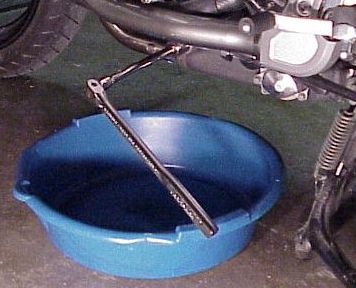
….Drain the engine oil completely from the crankcase, then replace the
engine oil drain bolt and torque to 31 ft-lb or 43 Nm, or firm up moderately
tight. SUGGESTION: A good torque wrench, not a "cheapo" is needed
over and over when working on your FZ1. Make the investment. Just one or two
wrenching jobs on your cycle will pay for the tools, and you know the job is
done right. y.
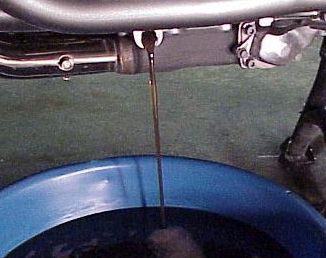
....HINT: to help eliminate oil
from getting on the header pipes, use some heavy aluminum foil to create a
funnel/tough to direct/catch the oil that will "spill" out of the
filter area. I try to make a little foil pan below the filter and on top of
the header pipes. A small hole is poked in the foil, trying to direct the oil
into the drain pan on the floor without running/dripping on the pipes. I am
generally partially successful. .
….Using an oil filter wrench (a number 4 from Auto Zone or Yamaha part
number YU-38411; better yet, just take a filter to the auto stores with you
and find an oil wrench that will fit) remove the oil filter cartridge.
….I had to initially use a breaker bar to loosen the original oil filter.
Locktite? I do not know but it was all I could to break both the drain bolt
and filter loose. The auto store filter wrench had to be held firmly/hard back
against the filter. Do not knock the bike off stand. I do not know if the
Yamaha wrench works better. I would assume it had a better fit to the filter,
but most of us will just take a filter to an auto supply store and pick up a
wrench.
….Install a new oil filter. Apply a thin coat of fresh engine oil to the
O-ring of the new oil filter cartridge first. BE SURE the O-ring is positioned
correctly in the groove of the oil filter cartridge.
….Torque the new oil filter cartridge to 12 ft-lb or 17 Nm if a torque
wrench is available, otherwise firm up the cartridge to about hand plus
tightness.
….Add fresh oil to through the engine oil filler cap/port. With a new
filter in place, you should be able to add 3.1 US quarts of oil or 3.0L. Note:
the total capacity of the oiling system is 3.8 US quarts or 3.7L, therefore
about 0.6 quarts of a pint plus of oil stays in the system upon oil change.
That is an amount like a 16oz overflowing pop bottle of old oil mixing with
fresh batch. If you do not change your oil filter every time, then add 2.9qt
or 2.8L of fresh oil.
….Install the oil filler cap, start the engine and idle for several minutes to check for major oil leaks. I do not like to have my cycles idling, so I generally go for a short, slow ride and stop to check for smaller leaks.
….After running the bike a little, check the oil level in the system by
placing the bike on center stand on level ground. The oil level should be
between the two lines in the site glass, which is under the clutch housing
area on the right side of the bike.
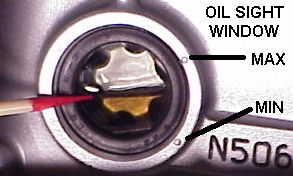
....Hint: It is important not to overfill the engine oil system. There is some thought that overfilling is worse then slight under filling, as the excessive oil causes the crank to froth the oil, meaning air is literally beaten into the oil bath, much like air is beaten into egg whites for some baking recipes. Which you mean a major loss of oiling/oil pressure in the total system.
Checking the Engine Oil Level often is a good idea!!
….Be sure the bike is upright on a level surface. Center stand will work.
….The engine oil level should be between the minimum level marks and maximum
level marks.
….Check the oil warm, and after it has been allowed to settle several
minutes.
....NOTE: The level of oil showing in the sight glass window is very
sensitive to the bikes position. When on center stand my FZ shows
completely overfilled. When tilted just a little it will show empty or
overfilled. I have found the best results on an absolutely level surface
with the bike not on center stand but tipped up as in riding position.
Be careful if you tilt the bike upright off the side stand, that it does not
get away from you as you look down to check the oil. It would be best to
have some straddle bike as you check the oil, and this would be a fairly
normal riding position for most of the time.
Manual's Direction for Checking the Oil Pressure
….Slightly loosen the oil gallery bolt (picture).
….Start the engine and keep it idling until engine oil starts to seep
from the oil gallery bolt.
….If no engine oil starts to seep from the oil gallery bolt after about
one minute, turn the engine off so that it will not seize
WARNING: DO NOT run an engine after the warning light comes on or after you
know there is no oil pressure. Unlubricated engines will destroy their contact
surfaces and seize up very quickly.
….If you have no oil pressure you will have to check the engine oil
passages, the oil filter cartridge and the oil pump for damage or leakage.
….Recheck the oil pressure after solving the problems.
….Tighten the oil gallery bolt to 7.2 ft-lb or 10Nm
The Violent World of Cycle Oil
in High rpm Engines
....These pics were taken during a GSX
and a FZ1dyno when the engine was head up at high rpms and then power
released. It is/was hard to time the pics so there is not timing
sequence. They are just random pic, but show how the oil bubbles, foams
and splatters around in the main oil galley.
Blue FZ1, oil??
My FZ1, oil Mobile 1 Cycle
GSX, oil??
|
My present opinion is that the FZ1 is an affordable, technologically modern riding and performing motorcycle which does a very good job of bridging the gap between my old Muscle Bikes ( V65 Magna & Vmax) and the sportbike developments of the recent years. Since the FZ has so much power and agility for all types of street riding it is very functional selection for a broad band of motorcyclists.
|
June 6, 2001---First Oil Change
at 500mi; used Yamalube 10W40.
....I changed the first time at 500 miles, however one can go longer on the
break-in oil, from 600-1200 miles. Like all oil issues there are
numerous opinions on when to change the first time and how often plus the oil
type to use.
...I will use Yamalube for the first change or about 2000 miles, then
transfer over to Mobil 1, full synthetic
cycle oil.
June 17, 2001--- Changed to
Mobil 1 Cycle at 2k
.....The FZ is relatively easy to work on with right tools. Tool 15
minutes to change oil and tighten chain.
.....Threw in three quarts of Mobil 1 cycle, left the oil filter in place.
First time in my life I have not put on a fresh filter when changing oil.
....Old dogs can learn new tricks. This filter only has 1500 miles on
it, and when really getting involved in the oil issue as the internet became
more functional starting about '94/'95 there were a number of folks that made
a very scientific argument for quality filters doing their best filtering
process after they are used for a few hundred miles up into the several
thousand. Thus, the thought was to change every 2-3 oil changes.
Most of us will not do that, but I am confident enough in the the theory to
leave this filter in place through the next oil change. There is nothing
magical about a fresh filter unless the old one has its "pores" shut
down so much they are not allowing enough oil to flow through and the by pass
is then letting "dirty" or unfiltered oil to go through the system.
But that is not going to be the case for at least past the third oil change
unless one has a really "bad" engine or is passing a lot of grit
into the oil through the air system.
....Again, do not do as I do, make your own decisions. I am just posting
what I am doing and what I pick up and process. One thing about not
replacing the oil filter too often is the filter maintains its oil charge.
There is a number of people quite concerned about what they consider is the
"terrible wear" time for an engine. They claim most wear,
70-90%, is from metal to metal contact during the time the lubrication coat is
lost or oil quantity/pressure is way down in the system. Such as after
long sitting periods and at oil changes. Using these thoughts, I tend to
change my oil in haste. I drain out the main quantity and not "drip
dry," plug it up, add oil, start it up and get going.
....I generally never idle or warm an engine up sitting around at low
rpm's, as this is another very vulnerable time. I start the engine, get
it running and drive off, warming up under light load/speed. I keep the
rpm's up to at least 2.5k and usually try to run very little time under 3k.
....Another thought on the superior qualities of synthetic oils, is the fact
it "stays" on the internal metal surfaces much better and for longer
periods of time, thus reduces the lubrication issue at start up, during cold
weather and oil change time.
....I will be interested if synthetic improves gas mileage on the FZ. I
have enough data recorded now to detect any changes. Generally, since
lubrication from synthetic oil is so much better, that with friction greatly
reduced the gas mileage will go up. Some folks claim 2-4 mpg. I
think they may be right on my Magna. On my Max, an educated guess would
be 1+ mpg more, but it is hard to tell, as the Max is such a "hot
rod" engine, it is very sensitive to riding style. In my experience
going from 26 (my lowest) to 48 mpg. The FZ, right now at least seems to
be getting 40-48 no matter how it is ridden.
....Bottom line, smoother shifting and smoother engine with synthetic
oil. I did not notice any clutch slippage but the initial 30 miles was a
cruise. I will monitor the clutch issue carefully. Synthetic has
been run for years in my Max and Mag without any detectable slippage to date
and both of these engine although old are still formidable weapons.
Use the FZ1 Sitemap to navigate all of the FZ pages.
|
|
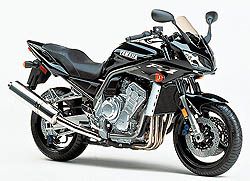
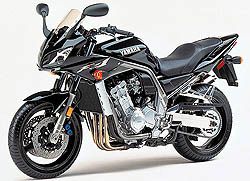
[] IowaZ Sitemap []
Send Email [] FZ1
Owner's Association [] IowaZ
Vmax Sitemap [] IowaZ
V65 Magna Page []
Any reproduction of this site or it's contents requires express written consent.
|
To Open a Search or Find-a-Word Window, press "Ctrl" and "F" at the same time. |